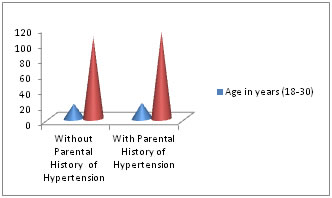Official Journals By StatPerson Publication
|
Table of Content - Volume 7 Issue 2 - August 2018
Study of parental history of hypertension on systolic blood pressure
Reddipogu Pavani1, Kunipuri Sarala2*, Akumalla Krishnaveni3
1Assistant Professor, 2Associate Professor, Department of Physiology, Kurnool Medical College, Kurnool, Andhra Pradesh, INDIA. 3Professor and HOD, Department of Physiology, Mamata Medical College, Khammam, Telagana, INDIA. Email: kunipurisarala@gmail.com
Abstract Hypertension is a common public health challenge. Early detection and appropriate treatment is the solution to this problem. The main objective of this study was to identify abnormal Blood Pressure responses in male adult normotensives with and without a parental history of hypertension. There was a significant difference in Systolic Blood Pressure between the two groups at baseline. Key Words: Hypertension Normotensive Parental history Systolic Blood Pressure.
Hypertension is an important worldwide public – health challenge because of its high frequency and concomitant risks of cardiovascular and kidney disease1,2. Hypertension has been ranked third as a cause of Disability – adjusted life years and identified as the leading risk factor for mortality. Family history is a major risk factor for Coronary Heart Disease which strongly predisposes to the atherosclerotic process at younger ages. In addition, cities are growing fast; modernization has resulted in stressful and hectic urban life style. The increasing incidence of Coronary Heart Disease is thought to be secondary to modernization which results in increased levels of stress, affluence which in turn brings about changes in life style. Therefore, identification of children who may be at excessive risk of future Coronary Heart Disease offers the possibility of preventing and delaying the disease by altering lifestyle. Measurements of blood pressure readings during basal conditions may be better indicator of mortality and morbidity risk. Given the health costs and potential importance of early detection of hypertension several studies have examined the blood pressure response to exercise as a risk factor for the development of hypertension 3,4.
MATERIALS AND METHODS The work was carried out at Government Medical College Kurnool in the department of Physiology for the selection of subjects. Prior to the study consent was obtained from the Ethical Committee and written consent was obtained at the time of recording blood pressure. We have selected 100 male subjects in the age group of 18-30 years with normal BMI and divided them as case group of 50 subjects with parental history of hypertension and 50 subjects without parental history of hypertension as control group by excluding any acute illness, Diabetes Mellitus, Anti-hypertensive medication, History of chest pain, breathlessness, orthopnoea, Physical disability like arthritis of the knee, any recent illness during the past two weeks or so. A brief history, general and systemic examination was performed. Subjects were interviewed the previous day and a detailed description of the protocol was explained to them. Blood pressure readings during basal conditions, ambulation or exercise are the best indicators of mortality and morbidity risk. Blood pressure recordings were taken in resting condition in supine position. RESULTS A total of 100 healthy normotensive males with normal BMI (18.5 -24.9Kg/m2) were chosen and divided into two groups as case group and control group. There were 100 subjects totally in both groups. Mean Basal Systolic Blood Pressure was significantly higher in the group with parental history of hypertension than in the group without the parental history. Table 1: Subject characteristics of normotensive males
Figure 1:
DISCUSSION Researchers have found that normotensive people who are at high risk of developing systemic hypertension have greater cardiovascular reactivity to physical stress. During the last three decades, researchers have recognized the significance of the relationship between autonomic system and cardiovascular mortality. Physical activity inhibits the vagal nerve impulses to the heart and increases sympathetic discharge. The inhibition of parasympathetic areas and activation of sympathetic areas of the medulla on the heart results in an increase in heart rate and myocardial contractility. The tachycardia and enhanced contractility increases cardiac output. As a result, there is an increase in heart rate and blood pressure. Besides that rise in the systolic blood pressure and a normal or low diastolic blood pressure is a normal response to isotonic exercise. A difference in baseline Systolic Blood Pressure found in those with parental history of hypertension may be an early marker of cardiovascular change in subjects with a genetic predisposition to hypertension. Subjects with parental history hypertension show an exaggerated Systolic Blood Pressure response to stress and exercise. Exercise blood pressure response and skeletal muscle vasodilator capacity in normotensive with positive and negative family history of hypertension demonstrates that the dynamic exercise blood pressure was exaggerated in normotensives with genetic risk of hypertension. Normotensive individuals who exhibit an exaggerated blood pressure response to exercise have an increased risk of future hypertension. Systolic Blood Pressure increases with all associated risk factors if a family history of hypertension is positive.
CONCLUSION Normotensives with parental history of hypertension have higher risk of developing cardiovascular disease and greater cardiovascular reactivity to exercise. The basal Systolic Blood Pressure was significantly higher in the group with parental history of hypertension than in the other group.
REFERENCES
|
|
 Home
Home

